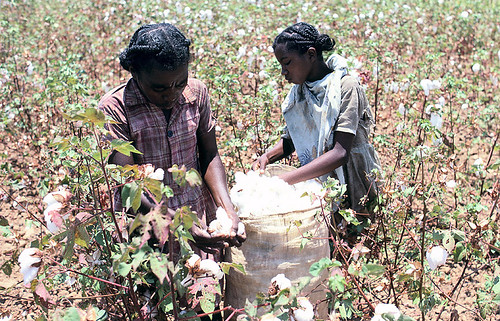March 2013
 |
| Women harvesting cotton. Madagascar. Photo: © Yosef Hadar / World Bank on Flickr |
For farmers who have escaped the GM
cotton debt trap and yield failures, there are other more pressing
concerns than the corruption of wild cotton at its centre of origin
in Mexico (see GM COTTON - HERE THERE... NOWHERE), or the
antibiotic-resistant bacteria in Chinese rivers (see A RECIPE FOR MRSA - March 2013).
The Soil Association
highlighted recently that conventional cotton is a 'toxic crop'. In
developing countries, cotton is thought to account for 50% of total
pesticides use. More toxic chemicals are used to grow cotton than
any other crop. Acute poisoning from pesticides is commonplace in
cotton production, with up to 77 million cotton workers suffering
poisoning every year. “These are the killing fields”.
Despite the 'Bt' insecticidal GM cotton which is supposed to obviate the need to spray, cotton farming uses 16% of all the insecticides sprayed each year, more than any other single crop. Monsanto now controls a staggering 95% of the cotton seed in India.
Cotton is also one of the thirstiest
crops we farm, using 11,000 litres of water for a single kilogram of
cotton produced. Besides feeding precious water to socks and
T-shirts, pesticidal pollution of rivers and drinking water is taking
its toll on the health of farming communities and their precious
ecosystems.
Using low external inputs that are
locally available, organic methods allow farmers to work within their
resources and work sustainably. Organic practices keep the soils
healthy so they're better at holding water and are more resilient to
drought conditions.
The Soil Association has launched a
major campaign to raise awareness of the human and environmental
consequences of non-organic cotton production. Check out
www.cottonedon.org
.
No comments:
Post a Comment
Thanks for your comment. All comments are moderated before they are published.